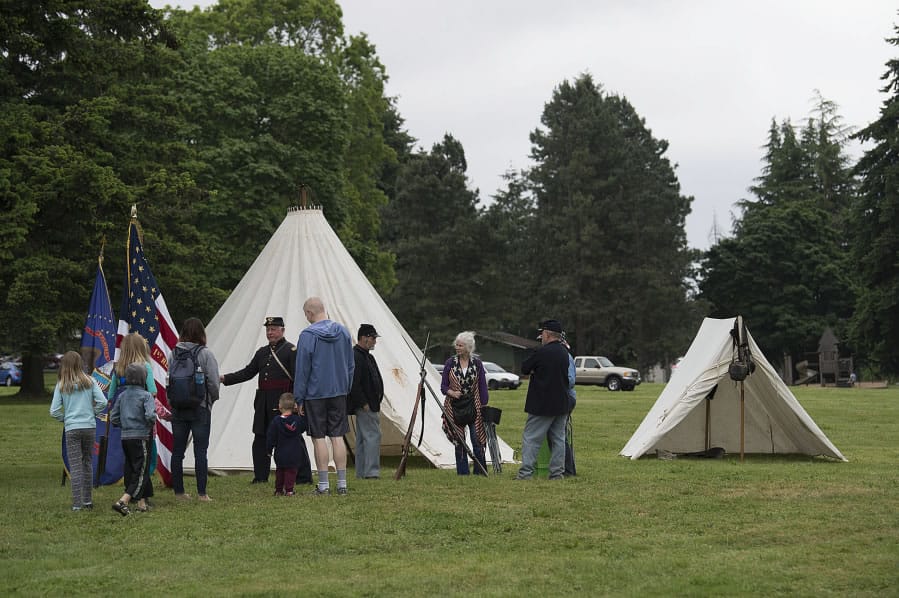Three eras of American history will share the weekend focus with the past tense of our national pastime.
The events Friday and Saturday at Fort Vancouver National Historic Site will highlight more than 80 years of local military history.
They include two military re-enactments and a “base ball” game played according to rules from the 1860s. There also will be an author’s discussion of primary figures in the Nez Perce War — Chief Joseph and Gen. O.O. Howard, a Medal of Honor recipient whose name is on a Vancouver Barracks landmark.
All events are free and open to the public.
WWII encampment
The most recent era of local military history will be the first to roll out Friday morning when the 113th Cavalry Living History Group hosts a World War II encampment just west of Pearson Air Museum, 1115 E. Fifth St.
The only two-day event of the weekend, it will welcome visitors from noon to 5 p.m. Friday and 9 a.m. to 5 p.m. Saturday. The camp will reflect the barracks’ role as a jumping-off point for troops.
“This was the Vancouver Port of Embarkation, and Army units were organized, equipped, and shipped out to combat theaters in Africa, Europe, and the Pacific from Vancouver Barracks,” said Bob Cromwell, the National Park Service’s chief of interpretation at Fort Vancouver.
“Getting them together as a unit was important,” Cromwell said. “There was a rail yard in the quartermaster area, where they were dropped off in the middle of the barracks.”
Rare WWII equipment and vehicles will be a part of the encampment. Historic uniforms and photographs will be on exhibit in the Historic Hangar at Pearson Air Museum; vendors also will also be selling American WWII uniforms and equipment for re-enactors and other collectors.
Civil War encampment
Re-enactors from the 1st Oregon Volunteer Infantry, a local living history group, will set up a Civil War-era encampment from 9 a.m. to 5 p.m. Saturday on the Vancouver Barracks Parade Ground, just south of Officers Row.
The group represents a military unit that was recruited to serve in the Northwest after the Union army pulled soldiers from Fort Vancouver for Civil War duty.
Visitors to the encampment will learn about military life during the 1860s and watch black powder musket demonstrations.
Since the 1st Oregon Volunteers stayed in the Northwest during the 1860s, the group has another identity that allows them to take part in Civil War re-enactments. As Company A of the 20th Maine, the group participates in Civil War events, and several of them took part in a 150th anniversary re-enactment of the Battle of Gettysburg in 2013.
Vintage base ball
At 6 p.m. Saturday, sports fans will be able to watch a baseball game played by the rules of the 1860s. Costumed volunteers from the national park and the 1st Oregon Volunteer Infantry will portray two of the Pacific Northwest’s earliest baseball teams: the Sherman Base Ball Club (consisting of Vancouver Barracks soldiers) and the Occidental Base Ball Club of Vancouver.
In base ball, the hurler — today’s pitcher — threw to the striker’s liking, and there were no called strikes. Players did not wear gloves, but they could catch the ball on one bounce for an out. Played in a “gentlemanly” manner, there was no sliding or stealing bases.
A study of base ball in 1867 in the Vancouver-Portland area written by former Fort Vancouver historian (and base ball player) Greg Shine is at go.usa.gov/5cmh.
Nez Perce War
Daniel Sharfstein will discuss his new book, “Thunder in the Mountains: Chief Joseph, Oliver Otis Howard, and the Nez Perce War,” from 1 to 3 p.m. Saturday at the Visitor Center, 1501 E. Evergreen Blvd.
Sharfstein, a professor of law and history at Vanderbilt University, writes that Gen. O.O. Howard was a champion of African-American equality after the Civil War and developed a new, expansive vision of what government should do for its people. But in the 1870s, his task was forcing Indians to become Christian farmers on government reservations. In 1877, he led troops against Chief Joseph, who resisted Howard’s plan.
Sharfstein writes that Howard’s role as an Indian fighter marked a betrayal of his civil rights work. Meanwhile, Howard was instrumental in turning Chief Joseph into a national celebrity by publicizing his surrender speech — ending with “I will fight no more forever” — and writing books about him.
As someone whose words were recited by school children, Chief Joseph became an icon of civil rights and nonviolent activism.
Sharfstein says that the war Howard and Joseph fought, a battle of ideas over the meaning of freedom and equality, is one that Americans continue to fight today.
Sharfstein’s appearance is sponsored by the Friends of Fort Vancouver; his book will be available for purchase.




